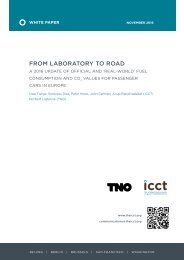Vol 55
Vol 55
Vol 55
- No tags were found...
Create successful ePaper yourself
Turn your PDF publications into a flip-book with our unique Google optimized e-Paper software.
42 David Lewisnotes that 19% of the energy in a monk's dietat Westminster Abbey was supphed through theconsumption of ale, compared to c.5% from thissource in the general population today (Harvey1993,58).Clearly the pressures of a growing Londonpopulation (possibly c.80,000 by 1300) and industrialexpansion were contaminating watersources, and some action was necessary to ensurepublic access to pure supplies. Uniquely amongstEnglish cities in the 13th century, the Londongovernment turned to technology to create anew source of piped water within the City.WATER TRANSPORTATION TECHNOLOGYThe diversion of naturally occurring watersources to centres of population was not a newtechnology; since the 12th century the monasticcommunities in England had used either stonelined open trenches or closed lead pipes toobtain a supply of running water within theirdomestic buildings. Of the two methods oftransporting water, stone lined trenches had theadvantage of being technically unsophisticated,but the disadvantage of being expensive andpotentially difficult to construct. They dependedon having both a conveniently situated andgeographically aligned source and destinationpoint, given that water would only flow along atrench if there was a downward slope between thetwo points. Without the construction of expensiveaqueducts to overcome river valleys or othergeographic features, stone lined trenches werein most cases not a viable means of transportingwater over substantial distances. The Romans,who are associated most with this method ofwater transportation, were only able to constructtheir urban water systems with an army of slavelabour, a resource unavailable to medieval urbangovernment. Occasionally medieval trench conduitswere built, but in these cases the diversionof water was over a relatively short distance and ina location where geography allowed a trench tobe constructed without the requirement to buildwater tunnels or aqueducts. Exceptionally, thereare also examples of a trench system being usedin conjunction with a piped supply, such as at StMary Spital, London (Thomas et al 1997, 43).Closed lead pipes or 'conduit' systems on theother hand were considerably more flexible;the source could be several miles from thedestination and the underground pipe couldrise and fall as the local topography required— the pressure within the pipe providing theenergy to make water flow uphill, if necessary.The critical requirement for these systems towork was the creation and preservation of 'head'water pressure within the system, by tapping asource spring that was at an elevation above thatof both the intermediate pipe and the destinationfountain. Typically water would be collected ata source spring (or springs) into a receipt tank(or head cistern) that provided both a reservoiragainst intermittent supply from the spring(s)and also a source of consistent pressure withinthe pipe. The greater the difference in heightbetween the source and the destination, thegreater the head pressure within the pipe andthus the greater the volume of water that could betransported. The disadvantage with lead conduits,however, was that they entailed the resolution ofa range of construction issues that did not applyin open trench conduits, and, in addition, postconstructionthey required a considerable amountof continuous maintenance. Take for examplethe lead pipes. The pipes had to be perfectlysealed to preserve pressure within the system;any imperfection in manufacture or subsequentdamage could result in local flooding and acomplete loss of water at the destination fountain.Not only was the production of perfectly sealedpipes difficult, but the buried pipes could beaccidentally damaged by inadvertent excavation,excessive surface pressure from urban traffic, orfrost damage in the winter. These dangers couldbe minimised by burying the pipe in a deeptrench, but if the pipe needed to be accessed formaintenance work, a deep trench would incurexcessive location and re-excavation costs. Abalancing of opposing technical issues was notlimited to the pipes, a range of other operationalaspects of the system also required carefulbalancing. Without the correct resolution ofthese issues, lead pipe conduits would eitherperform poorly, or not at all.The manufacture of robust water pipes wasthe initial technical difficulty in implementinga conduit system. Although some early conduitsin towns outside London used earthenware andwooden pipes, all the contemporary descriptionsof the first London conduit indicate that thepipes were made of lead. This metal was chosenbecause it is very malleable and has a relativelylow melting point, a necessary condition if thejoints between the sections of pipe were to besealed with molten metal as the pipe was laid.The method of making lead pipes was first to cast



